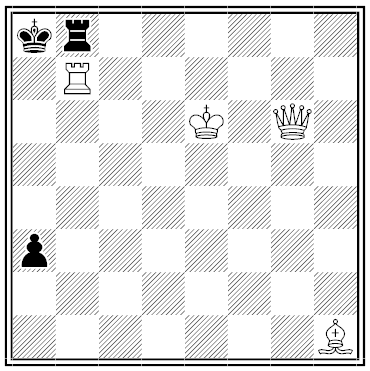
Disputed Disputation
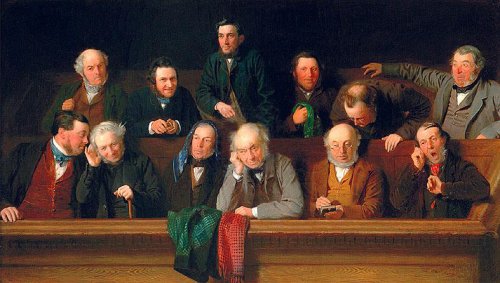
Some states permit less-than-unanimous jury verdicts in criminal cases. If a person is convicted of a crime in such a state by a jury that splits, say, nine to three, then has the defendant’s guilt been proved beyond a reasonable doubt? Does the mere existence of outvoted jurors (or their doubts) establish a reasonable doubt that should overturn the majority’s vote to convict? In Johnson v. Louisiana, 406 U.S. 356 (1972), the Supreme Court faced this question and held that it does not; even a split jury can convict a person beyond a reasonable doubt. But in Johnson, the Supreme Court was itself split as much as it could be, five to four. Is there a reasonable doubt as to what constitutes reasonable doubt?
— Peter Suber, The Paradox of Self-Amendment, 1990
Oedipus Wrecked
Jocasta Jones is walking in a wood when she discovers a deep freeze containing a man. She thaws him out, and he introduces himself as Dum and shows her a book that explains how to build a time machine and a deep freeze.
Jocasta and Dum marry and produce a baby, whom they name Dee. Dee grows up, discovers the book, builds a time machine and gets inside, taking his father and the book with him. The journey into the past takes a long time, and Dee is forced to kill and eat his father to stay alive.
Wracked with guilt, he emerges at his destination and destroys the machine. He changes his name to Dum, but still fearful of being punished, he builds a deep freeze and gets inside, taking the book with him. He is awakened by Jocasta.
Now, asks University of Nottingham philosopher Jonathan Harrison, “Did Jocasta commit a logically possible crime?” From her perspective, Dum enters her life, they have a child, and husband and child both disappear. But from Dee’s perspective, she has married her son and borne a child. Is this incest?
(Harrison, J. (1979) “Jocasta’s crime”, Analysis 39, 65.)
Over the Top
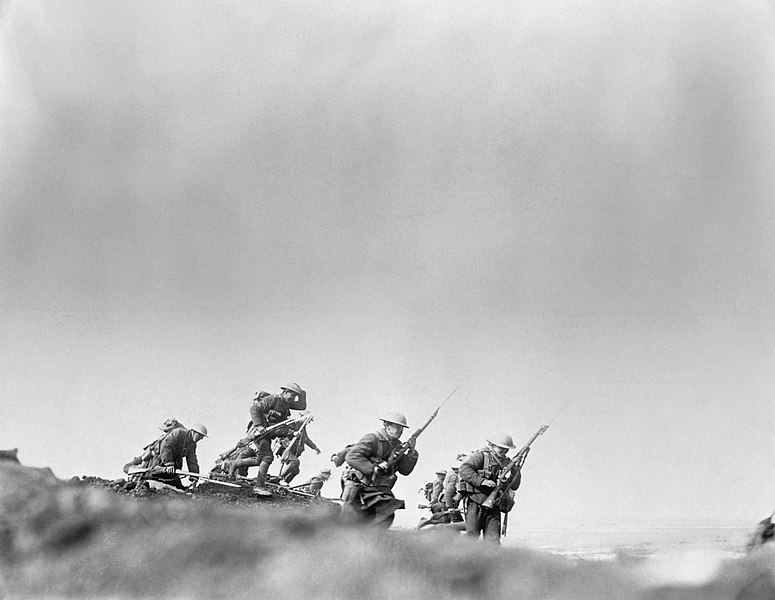
An infantryman’s view of World War I combat, from veteran Henry Williamson’s 1930 novel Patriot’s Progress:
… Half the sky leapt alight behind them, there were shouts and cries, a cascade of sound slipped solidly upon them, seeming to John Bullock to swell and converge upon the place where his now very trembling body was large and alone. He saw a long pale shadow before him an instant before it vagged and vanished in the shock of the earth rushing up in fire before him. He was aware of men going forward, himself with them, of the unreality of all movement, of the barrage which was all-weight and all-sound, so that he was carried forward effortlessly over a land freed from the force of gravity and matter. As in a nightmare of rising green and white showers of light about the rending fire he shouted without sound in a silent world, and his senses fused into a glassy delirium which lasted until he realized that of the figures on either side of him some were slowly going down on their knees, their chins on their box-respirators, their rifles loosening from their hands. He was hot and swearing, and his throat was dried up. That sissing noise and far-away racketting must be emma-gees. Now the fire wall was going down under his nose and streaking sparks were over and he was lying on his back watching a great torn umbrella of mud, while his head was drawn down into his belly …
(The vacuum of a dud shell falling just behind him.) He retched for breath. His ears screamed in his head. He crawled to his knees and looked to see what had happened. Chaps going on forward. He was on his feet in the sissing criss-cross and stinking of smoking earth gaping — hullo, hullo, new shell-holes, this must be near the first objective. They had come three hundred yards already! Cushy! Nothing in going over the top! Then his heart instead of finishing its beat and pausing to beat again swelled out its beat into an ear-bursting agony and great lurid light that leapt out of his broken-apart body with a spinning shriek
and the earth was in his eyes and up his nostrils and going away smaller and smaller
into blackness
and tiny far away
Rough and smooth. Rough was wide and large and tilting with sickness. He struggled and struggled to clutch smooth, and it slid away. Rough came back and washed harshly over him. He cried out between the receding of rough and the coming of smooth white, then rough and smooth receded …
Shell-shocked at the Somme, Williamson was invalided back to England in 1917, where he wrote seven novels about his wartime experiences. He died in 1977.
In a Word
eellogofusciouhipoppokunurious
adj. very good
(This has to be facetious, but I can’t find its origin. I’ve traced it back as far as Maurice Weseen’s 1934 Dictionary of American Slang, but he gives no source.)
Black and White
Asking Back
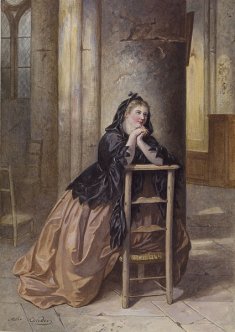
On the morning after a battle, Mary prays that her husband has not been killed. Is this a coherent plea? It would seem that the matter has already been decided: Her husband is either alive or dead. If he is dead, then in order to grant Mary’s prayer God would have to change the past retroactively.
“If one does not think of [such a] case, the idea of doing something in order that something else should previously have happened may seem sheer raving insanity,” writes Michael Dummett. “But suppose I hear on the radio that a ship has gone down in the Atlantic two hours previously, and that there were few survivors: my son was on that ship, and I at once utter a prayer that he should have been among the survivors, that he should not have drowned; this is the most natural thing in the world.”
Perhaps God can grant Mary’s prayer without changing the past: Perhaps, using divine foreknowledge, he interceded at the time of the battle knowing that she would later pray for this. “One of the things taken into account in deciding [the outcome], and therefore one of the things that really causes it to happen, may be this very prayer that we are now offering,” writes C.S. Lewis.
But this entails an oddity of its own — such favors, it seems, are available only to those who are in some doubt about a past event. God will intercede today for a prayer tomorrow — but only an uncertain person would make such a prayer. “I may pray that the announcer has made a mistake in not including my son’s name on the list of survivors,” Dummett writes, “but once I am convinced that no mistake has been made, I will not go on praying for him to have survived. I should regard this kind of prayer as something to which it was possible to have recourse only when an ordinary doubt about what had happened could be entertained.”
(Michael Dummett, “Bringing about the Past,” Philosophical Review, July 1964.)
Multiplication by Transplant



Limerick
A sleeper from the Amazon
Put nighties of his gramazon.
The reason? That
He was too fat
To get his own pajamazon.
— Anonymous
“Three Sundays in a Week”
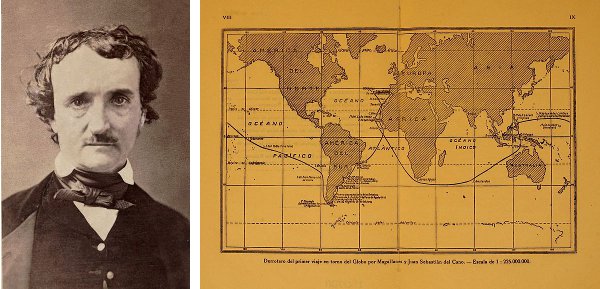
In 1841 Edgar Allan Poe pointed out the confusion that can result when a ship reckons time while circling the world. Captain Smitherton and Captain Pratt have just returned from circumnavigating the globe, one traveling eastward and the other westward, while Kate and her father Mr. Rumgudgeon have remained in London. On reuniting, they discover some confusion: Captain Pratt thinks that tomorrow will be Sunday, Smitherton thinks that yesterday was Sunday, and Kate and Rumgudgeon think that today is Sunday. Finally Smitherton says:
What fools we two are ! — Mr. Rumgudgeon, the matter stands thus: The earth, you know, is, in round numbers, twenty-four thousand miles in circumference. Now the earth turns on its own axis, spins round, these twenty-four thousand miles, going from west to east, in precisely twenty-four hours. Well, sir, that is at the rate of one thousand miles an hour.
Now suppose that I sail from this position a thousand miles east. Of course, I anticipate the rising of the sun here at London by just one hour. I see the sun rise one hour before you do. Proceeding in the same direction yet another thousand miles, I anticipate the rising by two hours; another thousand, and I anticipate it by three hours: and so on, until I go entirely round the globe, and back to this spot, when having gone twenty-four thousand miles east, I anticipate the rising of the London sun by no less than twenty-four hours; that is to say, I am a day in advance of your time. Understand?
But Captain Pratt, when he had sailed a thousand miles west of this position, was an hour, and when he had sailed twenty-four thousand miles was twenty-four hours, or one day, behind the time at London. Thus, with me, yesterday was Sunday; thus, with you, to-day is Sunday; and thus, with Captain Pratt, to-morrow will be Sunday. And what is more, Mr. Rumgudgeon, it is positively clear that we are all right.
Mr. Rumgudgeon, who had forbidden Kate to marry until there were “three Sundays in a week,” now relents. Too bad for him — the international date line would shortly obviate the problem.

